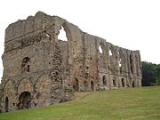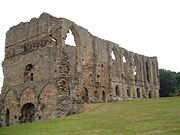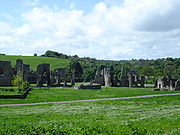
Easby Abbey
Encyclopedia



Premonstratensian
The Order of Canons Regular of Prémontré, also known as the Premonstratensians, the Norbertines, or in Britain and Ireland as the White Canons , are a Catholic religious order of canons regular founded at Prémontré near Laon in 1120 by Saint Norbert, who later became Archbishop of Magdeburg...
abbey on the eastern bank of the River Swale
River Swale
The River Swale is a river in Yorkshire, England and a major tributary of the River Ure, which itself becomes the River Ouse, emptying into the North Sea via the Humber Estuary....
on the outskirts of Richmond
Richmond, North Yorkshire
Richmond is a market town and civil parish on the River Swale in North Yorkshire, England and is the administrative centre of the district of Richmondshire. It is situated on the edge of the Yorkshire Dales National Park, and serves as the Park's main tourist centre...
in the Richmondshire
Richmondshire
Richmondshire is a local government district of North Yorkshire, England. It covers a large northern area of the Yorkshire Dales including Swaledale and Arkengarthdale, Wensleydale and Coverdale, with the prominent Scots' Dyke and Scotch Corner along the centre. Teesdale lies to the north...
district of North Yorkshire
North Yorkshire
North Yorkshire is a non-metropolitan or shire county located in the Yorkshire and the Humber region of England, and a ceremonial county primarily in that region but partly in North East England. Created in 1974 by the Local Government Act 1972 it covers an area of , making it the largest...
. The site is maintained by English Heritage
English Heritage
English Heritage . is an executive non-departmental public body of the British Government sponsored by the Department for Culture, Media and Sport...
and can be reached by a pleasant riverside walk from Richmond Castle
Richmond Castle
Richmond Castle in Richmond, North Yorkshire, England, stands in a commanding position above the River Swale, close to the centre of the town of Richmond. It was originally called Riche Mount, 'the strong hill'...
.
The Abbey of St. Agatha, Easby, was founded in 1152 by Roald, Constable of Richmond Castle. The inhabitants were canons
Canon (priest)
A canon is a priest or minister who is a member of certain bodies of the Christian clergy subject to an ecclesiastical rule ....
rather than monk
Monk
A monk is a person who practices religious asceticism, living either alone or with any number of monks, while always maintaining some degree of physical separation from those not sharing the same purpose...
s. The Premonstratensians wore a white habit and became known as the White Canons. The White Canons followed a code of austerity similar to that of Cistercian monks. Unlike monks of other orders, they were exempt from episcopal discipline. They undertook preaching and pastoral work in the region (such as distributing meat and drink).
Other former Premonstraterian houses in the north of England include Egglestone Abbey
Egglestone Abbey
Egglestone Abbey is an abandoned Premonstratensian Abbey on the eastern bank of the River Tees, 1½ miles south-east of Barnard Castle in County Durham, England, at...
in County Durham
County Durham
County Durham is a ceremonial county and unitary district in north east England. The county town is Durham. The largest settlement in the ceremonial county is the town of Darlington...
and Shap Abbey
Shap Abbey
Shap Abbey was a monastic religious house of the Premonstratensian order on the western bank of the River Lowther in the civil parish of Shap Rural, around from the village of Shap, in the Eden District of Cumbria, England...
in Cumbria
Cumbria
Cumbria , is a non-metropolitan county in North West England. The county and Cumbria County Council, its local authority, came into existence in 1974 after the passage of the Local Government Act 1972. Cumbria's largest settlement and county town is Carlisle. It consists of six districts, and in...
. Like most northern monasteries, Easby suffered from frequent Scottish raids during the Middle Ages
Middle Ages
The Middle Ages is a periodization of European history from the 5th century to the 15th century. The Middle Ages follows the fall of the Western Roman Empire in 476 and precedes the Early Modern Era. It is the middle period of a three-period division of Western history: Classic, Medieval and Modern...
. Ironically, great damage was caused to Easby and Egglestone Abbey
Egglestone Abbey
Egglestone Abbey is an abandoned Premonstratensian Abbey on the eastern bank of the River Tees, 1½ miles south-east of Barnard Castle in County Durham, England, at...
in 1346 when the English army was billeted there on its way to the Battle of Neville's Cross
Battle of Neville's Cross
The Battle of Neville's Cross took place to the west of Durham, England on 17 October 1346.-Background:In 1346, England was embroiled in the Hundred Years' War with France. In order to divert his enemy Philip VI of France appealed to David II of Scotland to attack the English from the north in...
.
In the late 1530s Henry VIII
Henry VIII of England
Henry VIII was King of England from 21 April 1509 until his death. He was Lord, and later King, of Ireland, as well as continuing the nominal claim by the English monarchs to the Kingdom of France...
dissolved the monasteries
Dissolution of the Monasteries
The Dissolution of the Monasteries, sometimes referred to as the Suppression of the Monasteries, was the set of administrative and legal processes between 1536 and 1541 by which Henry VIII disbanded monasteries, priories, convents and friaries in England, Wales and Ireland; appropriated their...
. The abbey was abandoned and left to fall into ruins, though some of the best features were salvaged: the fine canopied choir stalls are now found in Richmond parish church.
St. Agatha's Church (Easby Church)
St. Agatha’s Church (also called Easby Church) is located outside of Richmond, Yorkshire, and can easily be reached from Richmond via the trail alongside the river. The exact foundation date of Easby Church is unknown, but it is thought to predate the neighboring abbey. Little of the original church remains. St. Agatha’s retains medieval frescoes that were preserved through the Reformation after being whitewashed. The church and abbey are open free of charge to the public.In Easby Church is a plaster replica of the carved stone Easby Cross
Easby Cross
The Easby Cross is an Anglo-Saxon sandstone standing cross of 800–820, now in the Victoria and Albert Museum, London. It originally came from Easby near Richmond in the Richmondshire district of North Yorkshire, where a plaster replica is kept in the church. Easby was then in the Kingdom of...
. The original, which dates from the late 8th or early 9th century, is now in the Victoria and Albert Museum
Victoria and Albert Museum
The Victoria and Albert Museum , set in the Brompton district of The Royal Borough of Kensington and Chelsea, London, England, is the world's largest museum of decorative arts and design, housing a permanent collection of over 4.5 million objects...
.
The survival of this extremely rare early Christian cross is remarkable because when the church was being renovated the cross was broken up and used as convenient building stone in the new church. It was preserved there until it was found in the wall of the church and reassembled in the 20th century.

